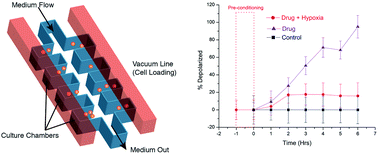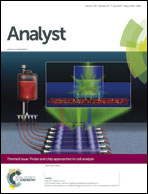Probing hypoxia-induced staurosporine resistance in prostate cancer cells with a microfluidic culture system†
Abstract
A microfluidic system for cell culture and drug response studies was developed to elucidate the effects of hypoxia on drug susceptibility. Drug response studies were performed in prostate cancer cells and Ramos B cells under normoxic and hypoxic conditions. A vacuum actuated microfluidic culture device was used for cell culture and PC3 cells were cultured in the chip up to 16 hours. Cells were treated with several concentrations of staurosporine and apoptosis was assayed using the fluorescent probes MitoTracker Deep Red and Annexin-V. For hypoxic samples, the chip was placed in a hypoxia chamber and pre-conditioned at <1% oxygen before inducing the cells with staurosporine. Cells exposed to 2 μM staurosporine were 32% ± 10% apoptotic under normoxic conditions but only 1.5% ± 12% apoptotic under hypoxic conditions. As little as 1 hour of hypoxic preconditioning increased drug resistance. Cell apoptosis correlated with drug dose, although in each case hypoxia reduced the apoptotic fraction significantly. Given the rapid nature of cell adaptation to hypoxia, this chip and analysis approach can be used to identify compounds that can induce cell death in hypoxic tumor cells rapidly.

- This article is part of the themed collection: Probe and chip approaches to cell analysis

 Please wait while we load your content...
Please wait while we load your content...